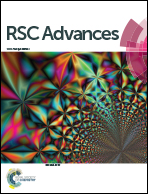A stereocontrolled synthesis of Hagen's gland lactones via iterative proline catalyzed α-aminoxylation and oxa-Michael addition reactions†
Abstract
A simple and efficient synthesis of Hagen's gland lactones was achieved using a sequential α-aminoxylation/oxa-Michael approach in a highly diastereoselective manner with assignment of relative configurations. This method was found to be applicable to the synthesis of various other isomers of Hagen's gland lactones.


 Please wait while we load your content...
Please wait while we load your content...